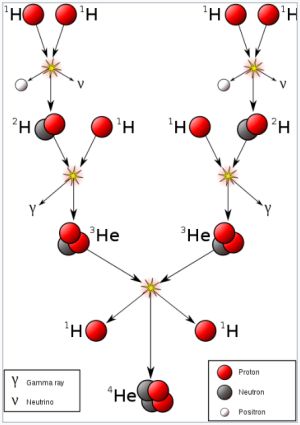There is a series of steps in this reaction. Each step releases energy, part of which we see as visible light
and feel as heat.
3Helium Production
Two protons (hydrogen nuclei) combine to produce one deuterium nucleus (2H) with one proton becoming
a neutron releasing a positron (anti-electron) and an electron neutrino. The positron annihilates with an
electron producing two gamma-ray photons. The deuterium combines with another proton to produce
3helium (3He), which is a light isotope of helium, plus another gamma-ray. While the temperature remains
around 10 M°K, not too much more happens. It is interesting to note that, on average, a hydrogen
nucleus has to wait for one billion years before it combines with another hydrogen nucleus. A star just
contains so many hydrogen nuclei, it is enough to keep it going.
PP I Branch
Once the temperature rises above 10 M°K, up to about 14 M°K, the PP I reaction combines two 3He
nuclei to produce one 4He nucleus and two hydrogen nuclei.
PP II Branch
Once the temperature rises above 14 M°K, up to about 23 M°K, the PP II reaction comes into play. In
addition to an abundance of hydrogen, there are 3He and 4He nuclei. A 3He and a 4He nucleus combine
to form 7Berylium plus a gamma-ray. The 7Be captures an electron and decays to 7Lithium plus an
electron neutrino. Finally, the 7Li combines with a hydrogen nucleus to form two 4He nuclei.
PP III Branch
Once the temperature rises above 23 M°K, the much rarer PP III reaction starts. Again, a 3He and a 4He
nucleus combine to form 7Be plus a gamma-ray. Now the 7Be combines with a proton to produce 8Boron
plus a gamma-ray. The 8Boron now decays into a 8Be nucleus and releases a positron, an electron
neutrino and a gamma-ray. Finally, the 8Be forms two 4He nuclei.
The energy production comes from the fact that the final 4Helium nucleus contains 0.7% less mass than
the original four protons. This mass is converted into pure energy, and is what powers stars like the Sun.
Proton-Proton Chain
Astronomy & Cosmology -
Life & Death of Stars


